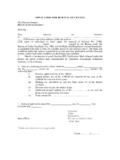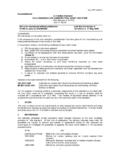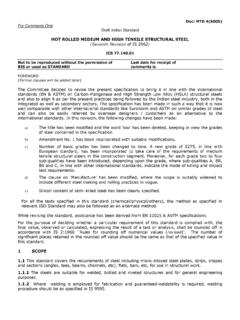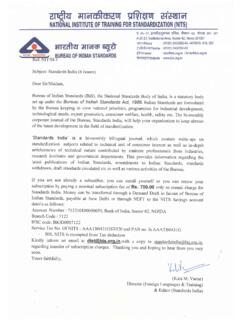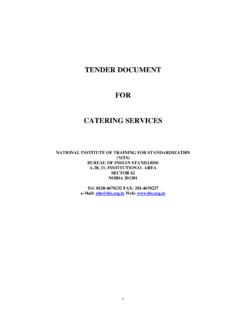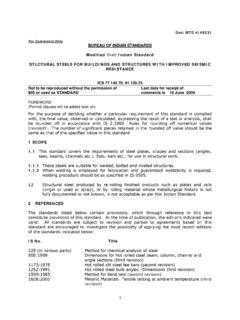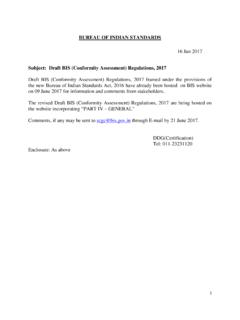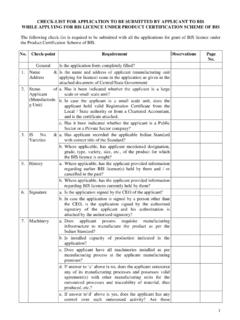Transcription of CRITERIA FOR DESIGN OF RCC STAGING FOR …
1 For BIS Use Only Doc: CED38 (7811)P June 2011 BUREAU OF INDIAN STANDARDS Preliminary Draft CRITERIA FOR DESIGN OF RCC STAGING FOR overhead water tanks ( first Revision of IS 11682) Special Structures Sectional Committee, CED 38 FOREWORD (Formal clauses of the standard will be added later.) This standard was first published in 1985. This first revision was taken up to keep abreast with the rapid developments in DESIGN and construction fields, and to bring further modifications in the light of experience gained. Liquid tanks are important public utility and industrial structures. Specifications, the DESIGN and construction method in reinforced concrete are influenced by the prevailing construction practices, the physical properties of the material and the environmental conditions.
2 Based on the experience in DESIGN and construction of STAGING of elevated tanks , necessity of revising the standard was felt (see Commentary, E-1). While the common methods of DESIGN have been covered in this standard code, DESIGN of structures of special forms or in unusual circumstances should be left to the judgment of the DESIGN Engineer and in such cases special systems of DESIGN & construction may be permitted on production of satisfactory evidence regarding their adequacy and safety by analysis or test or by both. If applicable at a particular location dust load should be accounted on roofs. In this standard it is assumed that the DESIGN of liquid tank and STAGING is entrusted to the qualified engineer knowledgeable with the current engineering practice related to RCC deign, and the execution of work is carried out under the direction of an experienced supervisor.
3 The DESIGN and construction of container for storage of liquid have been covered by IS 3370 (Parts 1 to 4), and this standard lays down the principles of DESIGN of STAGING for elevated liquid tanks All requirements of IS 456, IS 3370 (Part 1), IS 3370 (Part 2) and IS 1893 Part 2 in so far as they apply, shall be deemed to form part of this standard except where otherwise laid down in this standard. It is proposed that as and when IS 1893 part 2 is published, the clause & & Annex D shall be withdrawn. 1 For BIS Use Only Doc: CED 38(7811)P June 2011 The inner part STAGING in many cases is used for material and equipment storage, office space, and other applications.
4 Provisions in DESIGN are required for such requirements. This standard is drafted for common types of STAGING . Enough details may not be available for all other types of STAGING and possible configurations, for which designer is responsible for additional criterion for DESIGN . Liquid tank & Liquid container are treated as synonymous terms. In place of liquid , water may be used wherever appropriate by the user. Elevated water tanks in reinforced concrete are normally constructed under a lump-sum contract as deign & built contracts. The designs are checked by owner organizations or proof consultants. Hence all objective data should be clearly defined and for subjective decisions if required solutions should be defined, along with the data in contract document.
5 For the purpose of deciding whether a particular requirement of this standard is complied with, the final value, observed or calculated, expressing the result of a test or analysis shall be rounded off in accordance with IS 2:1960. The number of significant places retained in the rounded off value should be the same as that of the specified value in this standard. Page 2 of 44 For BIS Use Only Doc: CED 38(7811)P June 2011 Contents Scope References Terminology Symbols Specifications, DESIGN Report & Drawings Exposure Condition Concrete Structural Configuration of Members Stability of Structure Loads Load Combinations Analysis DESIGN Framed STAGING Modeling P- Effect Columns Braces Foundations Stair Shaft Type STAGING Detailing Construction Requirements Miscellaneous items & Appurtenances ANNEX A Referred Indian Standards ANNEX B Types of Stagings ANNEX C Structural Configuration of Members ANNEX D Response reduction factors (R)
6 ANNEX E Commentary Figures (To be included) Page 3 of 44 For BIS Use Only Doc: CED 38(7811)P June 2011 BUREAU OF INDIAN STANDARDS Preliminary Draft CRITERIA FOR DESIGN OF RCC STAGING FOR overhead water tanks ( first Revision of IS 11682) Special Structures Sectional Committee, CED 38 1 SCOPE This draft standard lays down CRITERIA for analysis, DESIGN and construction of reinforced cement concrete STAGING of framed type with columns or shaft type, for achieving a desirable level safety and durability of the supported liquid storage structure (container). Container may consist of any material like RCC, fiber concrete, ferrocement, steel, PVC, etc.
7 While the provisions of this standard refer to stagings for the storage of liquids, the recommendations are applicable mainly to water storage or containment. Additional requirements necessary for containment of liquids other than ordinary or plain water are beyond the scope. The requirements given in this standard are not applicable for STAGING in reinforced masonry or un-reinforced masonry, may it be in concrete block, stone or bricks. 2 REFERENCES The standards listed in Annex A, contain provision which through reference in this standard, constitute provisions of this standard. At the time of approval of this standard, the editions indicated are valid. All standards are subject to amendments and revision, and parties to agreements based on this standard are encouraged to investigate the possibility of applying the most recent editions of the standards being referred with their amendments.
8 3 TERMINOLOGY For the purpose of this standard, the following definitions shall apply. Capacity Capacity of the tank shall be the volume of liquid it can store between designed full supply level (FSL) and lowest supply level (LSL that is, the level of the lip of the outlet pipe). Due allowance shall be made for applying lining, coating or plastering to the tank from inside if any, when calculating the capacity of tank. The designated capacity of tank excludes dead storage which is the quantity of liquid below lowest supply level (LSL). STAGING It consists of components of structure supporting a liquid tank (container), to locate it significantly above general ground level. Pedestals or blocks Page 4 of 44 For BIS Use Only Doc: CED 38(7811)P June 2011 of short heights supporting a tank will not be called as STAGING .
9 In general the term STAGING includes the structural components for foundations also. Height of STAGING Height of STAGING is the difference between the lowest supply level of tank and the average ground level at the tank site. Liquid Depth Liquid depth in tank shall be the difference of level between lowest supply level (LSL) and full supply level (FSL) or working top liquid level (WTL) of the tank. In case of liquid being water , the term water depth can be used. The DESIGN liquid depth for tank can be more than the liquid depth due to dead storage and due to rise of liquid in freeboard zone to be accounted in DESIGN . Framed STAGING STAGING consisting of columns and braces. Shaft STAGING STAGING consisting of shell like a circular or polygonal cylinder or hollow prism.
10 Liquid Tower The structure consisting of tank ( container) together with the STAGING and foundation is termed as liquid tower. Force actions Include bending moments, torsion, shear forces, direct tension or compression. 4 SYMBOLS/ NOTATIONS DL - dead load DLp - provisional dead load IL - imposed load ILs - imposed load due to storage ILp - imposed load due to an operation or equipment WL - wind load or seismic load FL liquid (fluid) load WTL - normal working top liquid level FSL - full supply level MTL - maximum top liquid level LSL lowest supply level P- effect effect of vertical load with horizontal deflection resulting in increased bending moments. R response reduction factor RCC - reinforced cement concrete k1, k2, k3 - wind speed factors Ht - total height of tower (including container) h - depth of liquid in tank Cf - force coefficient (for wind load) SMRF special moment resisting frame ductile frame (ref IS 1893 & IS 13920) OMRF ordinary moment resisting frame not confirming to IS 13920 fy - characteristic strength of reinforcement bars, yield or proof stress.
